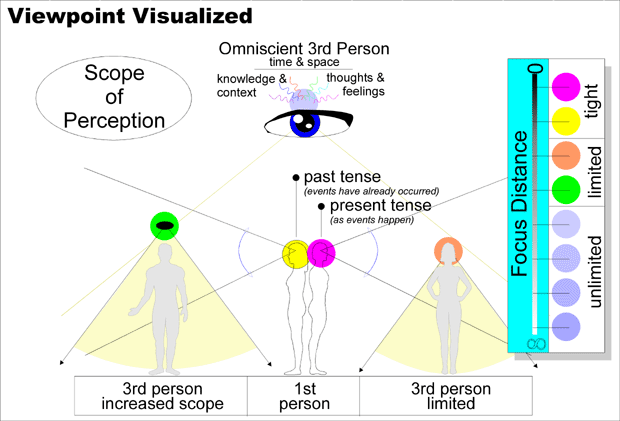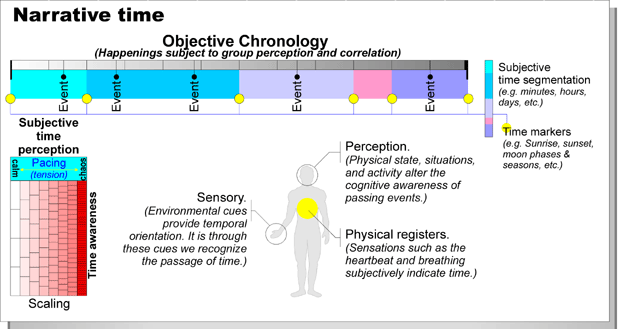Writing: The POINT of Point Of View
Opinions, viewpoints, perspectives, insights and revelations— all of them are different things, but they have one thing in common; they relate to an individual’s understanding of people, their environment, situations, and emotional contexts. They are also the critical aspect of any story. They are the eyes and ears that allow a reader to better understand the world that your characters live in.
Stories are about people. People have emotions, sensations, reactions, opinions and prejudices. Without a character that a reader wants to root for, villains they hate and heroes they love, there is nothing to tie them to the story. Lose your reader and your manuscript lies abandoned at the bottom of the slush-pile.
What is a character really? A personality. What is a personality? It is often a distinct way of thinking, doing, and perceiving things. How is personality best depicted?
Through point of view.
Point of view or POV is the reader’s window into the world that is your story. That window can be transparent and totally objective (expositive) or it can be filtered through the knowledge, understanding, and quirks of personality. It is the latter that allows us to show character, and allow readers to ‘walk a mile in another person’s boots’. That is the essence of storytelling, sharing in the lives of other people (and creatures).
POV is one of the most complicated and subtle aspects in writing. It is the difference between immersive narrative and exposition (which was discussed in the previous section). When first talking about point of view is best to understand the different types and visualize the subtle (and not so subtle differences). For most people, there are only three forms of POV; first, second, and third. Actually, there are closer to a dozen distinct techniques for showing character. The diagram below deals with the eight most common and easily recognized types of viewpoint.

As you look at this diagram you will probably notice things broken up in ways you haven’t before. To start with, first person POV is broken into two types, present tense and past tense. If you’re unfamiliar, first person point of view, is the story told entirely by the ‘I’ character. The story never (normally) leaves that character’s thoughts, sensations, and perspectives. The ‘I’ story is also where the aspect of the unreliable narrator most comes into play. Like any person telling a story, the ‘I’ character can be dishonest, and not necessary reveal everything in its true light. You might wonder why past tense and present tense 1st person are separate POVs in this diagram. This is done because the two techniques have dramatically different styles. First person present tense has tough and often complex hurdles that must be dealt with that a writer doing a past-tense narrative does not face.
You will notice that 3rd person viewpoint has been broken into several types that start with 3rd person limited POV and end with the various omniscient viewpoints. You will not find this distinction in typical writing classes by the way. The best I have noted is a distinction between omniscient and more limited third person. Third person limited is an objective viewpoint that simulates 1st person. In this, we mean that it accepts the limitations and techniques that apply to first person narrative while maintaining some of the flexibility in 3rd person (objective) viewpoint. The reasons for accepting these limitations is that it results in a more immersive experience for the reader, because all the narrative is through the eyes and ears of one character, and we get to know that character very well.
Next is third person increased scope. This is the “typical” third person narrative that most of us are familiar with. The viewpoint is more flexible, and it’s not uncommon for us to experience the story through more than one character’s perspective. Note, that this viewpoint does not allow us (in narrative) to see the thoughts of characters other than the POV character.
Beyond the increased scope 3rd person are four levels of omniscient viewpoint. They really don’t have specific names. The closest omniscient 3rd person is often portrayed through a character that has super-human insight into the thoughts and emotions of other characters. There are a few literary examples of this. The thoughts of other characters are still given through the viewpoint of the narrating character however.
The second level of omniscient, we have restrained “head hopping”, meaning from time-to- time the narrative will switch from one character’s perspective to another within a scene.
The third level of omniscient is less restrained, and the writer as narrator begins to become present in the story and not only do we get information from the viewpoint character, but we often hear the thoughts of other characters freely without regard to a “coherent” viewpoint.
The fourth and last level of omniscient is total freedom, jumping in and out characters at will and knowing contexts and situations that are beyond the understanding of the characters in the story. In other words, the story is really not related through the character but through an all-seeing all-knowing camera that tracks their movements and activities.
What is key to note here is that the further we track away from the character focus (shown in the meter that says ‘Focus Distance’), the more disassociation that occurs with the protagonists of the story. This is NOT a good thing. So, it is something to be aware of as you write. How much time are we spending in the protagonist’s head, how well do we know them and are they likeable? The only way those questions can be answered is if enough of their personality and mannerisms are reflected in the narrative.
Awareness of time, the key to viewpoint
When the reader begins to sense, mark, and understand the passage of time is when you as a writer have succeeded in creating an immersive narrative. We don’t mean when they know time passes because you write a transition like ‘the next day’. No, we are speaking of when the words, as read, have a synchronicity with the story events as they happen. To clarify, we are saying in the time it takes the reader to read the words, things take place in the story in a nearly one-to-one relationship. The nuances and techniques of making this possible are a goal to strive toward.
To see some of this in effect consider the following excerpt:
Serik ran down the alley, his hand covered in blood. He stopped to listen for pursuit coming down the street thronged with merchants. The hammering of his heart made it hard to distinguish individual sounds out of the crowd noise. Face chilled and chest hurting, his breath made clouds in the frosty air. The voices of hawkers, pages, and arguing patrons rose above the dissonance from time to time.
No guard whistles.
I shouldn’t have panicked. Now, I’m in it deep.
Serik’s hand tightened. Blood seeped between his fingers and around the pommel of the curved leather knife. He sheathed the tiny blade.
Had they given up? He doubted it. He brushed away the strands of hair that sweat had plastered to his face. He rubbed the crystalline bracers on his wrists, praying their magic would help him. The Tymoran priestess told him they were a gift from his father. He’d worn the broad transparent bands since he could walk. Serik always feared that when he needed it most, their protective magic would fail and leave him spitted on some warrior’s sword.
Keep moving.
The smells of urine, rotting vegetables and wood grew stronger as he headed toward the deepest shadows. Mulmaster’s buildings sprawled across one another like drunken titans, their stony skins soot-covered and pitted.
A horse whinnied. A deep voice bellowed rapid queries.
Damn.
He broke into a jog. Mulmaster’s law could be evaded in only two ways; by going far enough into the mountains or by staying concealed until the incident had been forgotten.
Ducking around a building, he leaned into the incline. The cobbled hillside grew steeper as he headed southeast. Through gaps between the buildings, he saw Wyvern Keep. Outlined against the pewter sky, the castle’s spires jutted up like claws.
Hooves clattered on cobbles. The same voice rapped out orders. They must have a tracker or a Cloak mage with them.
Serik stumbled through debris and leaped to grab the upper edge of a wooden barrier. The rotten wood creaked and swayed under his weight as he swung his foot over.
A sharp voice came from nearby. “Over here! This way!” Steel shrieked. Footsteps became audible.
He lunged forward, tumbled over the far side into a stinking pile of refuse. Rats and insects skittered into the darkness.
Another voice joined the first one. “Where’d he go?”
“Over that fence!”
Serik righted himself. He should never have tried picking pockets in this wretched city. Stupid. More so, letting himself get distracted so he’d cut that merchant rather than his purse.
“Cloak! This way!”
He turned another corner. The sound of shattering wood echoed behind him. He zigzagged around dirt fills and trash heaps. His chest ached. His sweat felt icy. Crashing sounds came from his left. More men had joined the chase. Noises on his right and left now.
They were surrounding him…
There are several narrative and point of view techniques in this that bare mentioning. The first to note is the use of 1st person thoughts. Some of the character’s thoughts are run in first person and italicized. This is a fairly common mechanism to give a sense of immediacy. Some people are bothered by it because it is essentially a tiny viewpoint shift each time it takes place. This writer chose to do it, feeling that the effect outweighed the potential drawbacks.
Notice the use of physical registers throughout the piece. This includes his heart, breathing, sensations, smells, and all the details you need to be running through Mulmaster’s alleys with Serik as he tries to elude the guards. Notice the use of shorter and longer sentences and how they give a breathless sensation. This is a deliberate structuring to create syncopation we referred to as an awareness of time. As the reader becomes involved they react and act through the story with Serik.
Another thing to note is that Serik is alone in this scene but there is still dialogue. Serik, in essence, speaks to himself. Also, notice that it’s not immediately said why Serik is running, but by the end of the excerpt we know. You will also note the sections that give hints to questions that will be answered in the future. The last, and potentially the most important thing to know about this text is that nowhere in it is there exposition. It is shown to us from word one, little is explained, but we know enough about what’s going on to be oriented and and are potentially given enough characterization to like and care about the beleaguered Serik and the critical mistake that is about to change his life.
To continue the discussion of time in POV consider the following diagram:

This diagram visually illustrates some of the techniques used in the action example. The graph called “subjective time perception” is a representation of how when tension goes up dramatically, that time actually seems to slow down. It’s not that time slows, but the fact that we are registering things in the environment more rapidly. In the writing itself, it is accentuated by short choppy sentences, and sometimes fragments. Another thing illustrated in the diagram is the idea of objective chronology. This is the marking of time through observable phenomena. If, in your story, you describe the sun as being high in the sky you have essentially SHOWN what time it is. If a few paragraphs earlier you described the sun rising, then you have demonstrated the passage of time—without telling the reader time passed. The narrative is simply marking time no particular attention needs to be drawn to it, in fact, no attention should be drawn to it. A seamless narrative gives us the elements of time and orientation without ostentation. Often the best writing is when the reader doesn’t notice it, but instead only perceives the story.
With this section we’ve basically touched on point of view and how it affects the affinity a reader has for the story. We also discussed how time is essentially the most critical element in effective viewpoint. In the next session we’ll continue to build on the elements of viewpoint, and work with narrative voice and character dialogue
